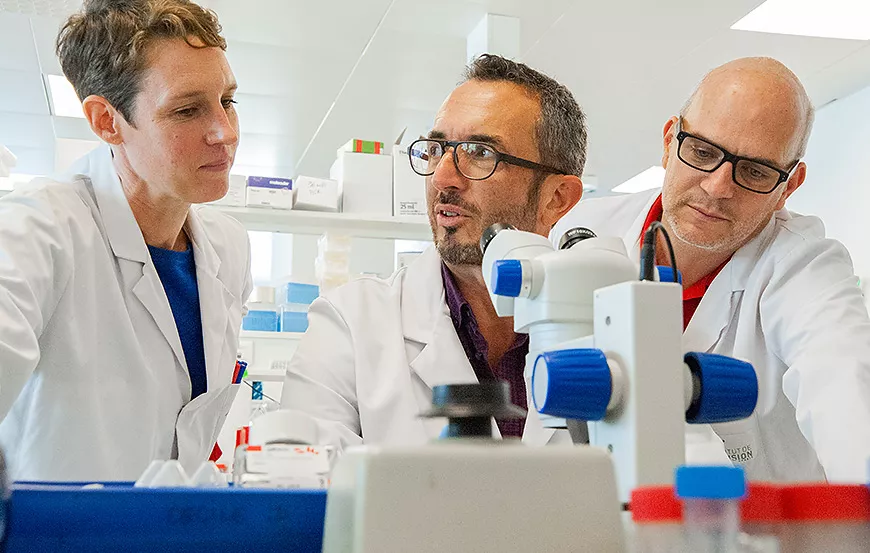Age-Related Macular Degeneration (AMD)
Age-related macular degeneration (AMD) is a growing problem due to the ageing of the population. This multifactorial disease never causes total blindness because the peripheral part of the retina remains intact.
Disease simulation

Definition and symptoms
What is AMD?
It’s a degeneration of the macula, the central area of the retina responsible for seeing details. AMD does not cause blindness, as peripheral vision is preserved. It affects 1 million people in France.
There are two forms of AMD: Atrophic (or dry) AMD, which is slow-growing. It accounts for 80% of AMD. This is a progressive destruction of the photoreceptors of the retina. Exudative (or wet) AMD, which progresses rapidly. It accounts for 20% of AMD. This is the proliferation of abnormal vessels on the retina.
Who can be affected?
AMD mainly affects men and women over the age of 60.
How does it affect patient?
A person with AMD suffers from a decrease in visual acuity (blurred vision) despite having an appropriate optical correction. A central spot or area of "absent" vision (called a scotoma) appears as well as a sensitivity to light (photophobia). However, the affected person will need a strong supply of light to perform specific tasks, such as reading. In addition, images can become distorted (such as wavy lines instead of straight lines: metamorphopsia) for the exudative (or wet) form of AMD.
Treatments for AMD
For the atrophic (or dry) form of AMD: there is as yet no treatment, but dietary supplements can be taken as a preventive measure.
For the exudative (or wet) form of AMD: new drugs (anti-VEGF) can slow progression or stabilise the disease. These injections can be given in the ophthalmologist's practice and do not require hospitalisation.
Gene therapy trials are currently underway.
Possible difficulties faced by people with AMD
For people with AMD, it’s difficult to recognise faces and signs in the distance: road signs, film subtitles, pedestrian lights, and so on. Reading a book, newspaper, magazine or information on a screen and looking at photos, for example, also becomes difficult.
Research by the Institut de la Vision
Developing a treatment
Developing a treatment to counteract cone photoreceptor degeneration and chronic inflammation of dry AMD
3 teams are involved in the project:
Serge PICAUD / Olivier MARRE team : visual information transmission: coding and visual restoration
Florian SENNLAUB and Équipe Deniz DALKARA team : inflammation and immunology of retinal pathologies

Preventing the death of cones
AMD leads to the atrophy of photoreceptor cells, leading to a slow but gradual loss of visual acuity. One of the avenues currently being studied is that of neuroprotection: through molecules that would prevent the loss of photoreceptors by acting on the mechanisms of destruction of these cells. This strategy could help maintain central vision by helping cells better resist oxidative stress.
Successfully regulating inflammation
The Institute is very interested in the role of chronic inflammation in atrophic AMD, as the loss of photoreceptors is probably the result of inflammatory reactions triggered by oxidative stress. This inflammation is marked by an accumulation of macrophages (inflammatory cells) under the retina. These macrophages, initially designed to cleanse the tissue of dead cells, can in turn lead to the death of photoreceptor cells, producing a vicious circle leading to blindness.
